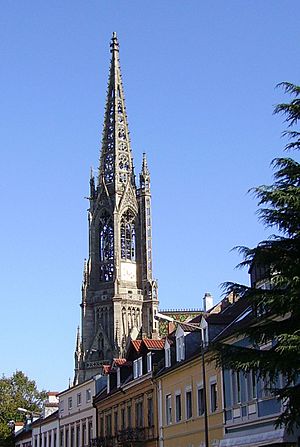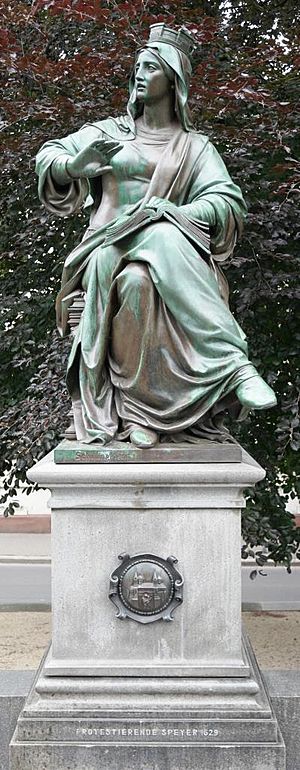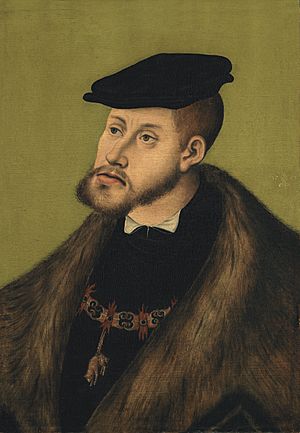Protestation at Speyer facts for kids
On April 19, 1529, an important event happened in the city of Speyer, Germany. Six powerful princes and representatives from 14 free cities gathered at a big meeting called the Imperial Diet. They spoke out against a ban on Martin Luther and his ideas. They also wanted to make sure that the evangelical faith could spread freely. This event became known as the Protestation at Speyer. It was a key moment in the history of Protestantism.
Contents
Who Were the "Protestants"?
The people who protested at Speyer were called "Protestants." This name came from their act of "protesting" the decisions made at the Diet.
The Six Princes Who Protested
These powerful leaders stood up for their beliefs:
- John the Steadfast, the Elector of Saxony
- George the Pious, the Margrave of Brandenburg-Ansbach
- Ernest I the Confessor, Duke of Lüneburg-Celle
- Francis, Duke of Gifhorn (Ernest's brother)
- Philip I the Magnanimous, the Landgrave of Hesse
- Wolfgang, the Prince of Anhalt-Köthen
The 14 Free Cities That Protested
These cities were important because they governed themselves. Their representatives also joined the protest:
- Strassburg
- Augsburg
- Ulm
- Konstanz
- Lindau
- Memmingen
- Kempten
- Nördlingen
- Heilbronn
- Reutlingen
- Isny
- St. Gallen
- Weissenburg
- Windsheim
Cities That Changed Their Minds
Some cities first supported the protest but later withdrew their support:
Why Did They Protest?

The protest happened because of earlier events. Eight years before, in 1521, Martin Luther was banned by the Holy Roman Empire at another meeting called the Diet of Worms. This meant his teachings were forbidden.
Emperor Charles V wanted to stop the religious arguments between the Catholic majority and the evangelical minority. He called the Second Diet of Speyer to try and solve these problems.
Earlier Decisions and New Rules
In 1526, a previous meeting in Speyer decided that each prince could choose the religion for his own lands. This gave some freedom to the evangelical faith.
But on March 1, 1529, Emperor Charles V announced a new Diet in Speyer. He sent his brother Ferdinand to represent him because he was busy with a war against France.
The new rules said that no new religious changes were allowed until a big church meeting (a council) could happen.
The Protest Begins
On April 19, most of the representatives at the Diet agreed to cancel the earlier 1526 decision. This meant the freedom given to evangelical princes was taken away. The evangelical group was told to accept the majority's decision.
The evangelical princes then left the meeting hall. When they came back, Ferdinand did not want to listen to them. So, their objection was read out loud. They protested against undoing the 1526 decision. Ferdinand demanded that they "accept and obey the decision."
The Protestant leaders refused. They believed that earthly rulers should not control matters of faith.
The Letter of Protestation
On April 20, the Protestant delegates presented a document called the "Letter of Protestation." Ferdinand refused to accept it, so it was not read aloud at the Diet. However, it was printed and shared with the public.
The "Letter of Protestation" was signed by:
- Johann, Elector of Saxony
- Georg, Margrave of Brandenburg
- Ernst, Duke of Braunschweig-Lüneburg
- Philipp, Landgrave of Hesse
- Wolfgang, Prince of Anhalt
At the final meeting on April 24, the Diet's decision was read again. But there was no mention of the evangelical princes' protest.
The Birth of Protestantism
Because of this, on April 25, the evangelical princes and city representatives met again. They wrote another document called the Instrumentum Appellationis. This document listed their complaints against the Diet's decision. They sent this text to the Holy Roman Emperor.
Since this Diet in Speyer, followers of the reform movement became known as "Protestants." This protest by the princes and free cities is often seen as the beginning of Protestantism.
Who Protested the Diet's Decision?
Many important people supported the protest:
- Elector John the Steadfast of Saxony
- Gregor Brück (Pontanus), John's Chancellor
- Philipp Melanchthon, a close friend of Elector John
- Simon Grynaeus, a friend of Philipp Melanchthon
- Johann Agricola, John's chaplain
- Landgrave Phillip of Hesse
- Erhard Schnepf, Philip's chaplain
- Margrave George of Brandenburg-Anhalt
- Duke Ernst of Braunschweig-Lüneburg
- Duke Franz of Braunschweig-Lüneburg
- Johann Förster, Chancellor for Dukes Franz and Ernst
- Prince Wolfgang of Anhalt
- Count William of Fürstenberg
- Mayor Christoph Tetzel, from Nürnberg
- Mayor Christoph Kreß, from Nürnberg
- Mayor Bernhard B(P)aumgärtner, from Nürnberg
- Councillor Jakob Sturm, from Straßburg
- Guildmaster Matthias, a clergyman from Straßburg
- Mayor Bernhard Besserer, from Ulm
- Mayor Sebastian Hagelstein, from Windsheim
- Mayor Josef Weiß, from Reutlingen
Who Voted for the Diet's Decision?
These leaders supported the Emperor's side:
- Holy Roman Emperor Charles V (though he was not there in person)
- Ferdinand, Charles V's representative
- Grand Chancellor Bernhard Cles, Bishop of Trent
- Freiherr Georg Truchsess von Waldburg, King Ferdinand's vice-regent
- Dr. Johann Faber, a church official from Konstanz and Basel
- Probst Balthasar von Waldkirch
- Frederick II, Elector Palatine
- William IV, Duke of Bavaria
- Leonhard von Eck, Duke Wilhelm IV.'s chancellor
- Louis X, Duke of Bavaria
- Eric I, Duke of Brunswick-Lüneburg
See also
 In Spanish: Protesta de Espira para niños
In Spanish: Protesta de Espira para niños
- Speyer Memorial Church, a church built in 1904 to honor the Protestation.





